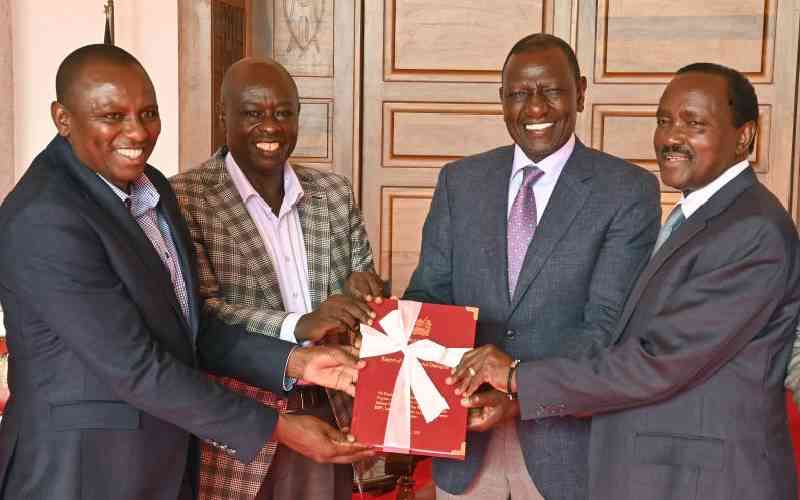After a long legal battle that ended in the Court of Appeal on July 21, 2017, the Independent Electoral and Boundaries Commission (IEBC) was given the green light to engage Dubai-based printing firm Al-Ghurair in producing ballot papers.
Kenya has had a longstanding negative history with ballot papers - which is not limited to ballot stuffing, spoilt votes and irregular ballot papers.
But do we really need to contract any firm to print our ballot papers?
The IEBC, or any other electoral body, does not need to contract anyone to print ballot papers.
Chapter Seven of the Constitution and the preceding Election Offences Act 2016 define a “ballot paper” as a paper used to record the choice made by a voter and shall include an electronic version of a ballot paper or its equivalent for purposes of electronic voting.
New method
In essence, this definition elucidates that a ballot paper can be physical and electronic – depending on the most applicable format and version.
Another dimensional concept on ballot paper was explained in the 2013 and 2017 Supreme Court ruling that clarified the effect of rejected votes (wrongly used ballot papers) on the final results of an election tally.
In both cases, the Supreme Court found that rejected ballot papers were invalid and could not be included while tallying results for candidates.
In other words, this ruling somehow wants IEBC to develop Ballot Management System (BMS) and Results Management Framework (RMF), which will entirely eliminate rejected votes, and this is what forms the basis of my concept, On-location Ballot Printing and Casting.
On-location Ballot Printing and Casting is not an entirely new concept since it has incorporated other existing ideas that, if well implemented, would enhance transparency in elections, reduce the cost of conducting elections and create verifiable application levels.
The IEBC in collaboration with other organisations has developed the Kenya Integrated Election Management System (KIEMS) that has three most essential application levels – registration of voters, identification of voters and transmission of results.
Application levels
KIEMS has been developed in a way that it allows for expansion, upgrading and integration of other application levels for purposes of improving electoral processes.
Stay informed. Subscribe to our newsletter
However, KIEMS has loose ends that make it very vulnerable and expensive.
For example, KIEMS does not have the technological proficiency to identify, tabulate and transmit results on a single digital communication device and system layer – hence creating unnecessary hurdles.
The OBPC concept on the other hand aims to upgrade KIEMS so that biometric data stored in KIEMS devices can be used to identify a voter through a ‘touch-to-vote' mechanism.
In this case, a KIEMS device with biometric data of voters will be plugged to a new machine known as Station Ballot Tabulator (SBT) – with a pagination screen that displays the names of candidates as per the positions they are vying for.
The SBT will also be connected to a transactional printing device.
On voting day, a potential voter will walk directly to the SBT pagination screen and use his or her fingerprint to select the candidate he or she is voting for.
Fingerprint identification
The fingerprint identification slot on SBT uses an algorithm known as Automated Fingerprint Identification Systems (AFIS) to identify and verify a potential voter whose biometrics have been stored under Wavelet Scalar Quantisation (WSQ), a compression algorithm for gray-scale fingerprint imagery.
After a voter has selected a candidate, the transactional printing device will facsimile out his or her recorded choice on a transactional ballot paper with programmatic security identifiers on it.
The voter will then confirm his or her choices before dropping the physical ballot papers in the various ballot boxes representing different candidates.
The SBT has an encryption capability that allows it to store, display and transmit results without making any alterations to them.
At the end of the voting exercise, presiding or returning officers will simply press the tabulation button on the SBT so it can display results for each candidate.
The election officials will also lead in counting of the physical ballot paper, which will be used to verify the veracity of the entire process, and make comparisons. In this process, there will be no rejected votes.
The OBPC concept will save the country billions of shillings while making electoral processes simpler and foolproof.
Mr Asuella is Online Editor at The Standard
 The Standard Group Plc is a
multi-media organization with investments in media platforms spanning newspaper
print operations, television, radio broadcasting, digital and online services. The
Standard Group is recognized as a leading multi-media house in Kenya with a key
influence in matters of national and international interest.
The Standard Group Plc is a
multi-media organization with investments in media platforms spanning newspaper
print operations, television, radio broadcasting, digital and online services. The
Standard Group is recognized as a leading multi-media house in Kenya with a key
influence in matters of national and international interest.
 The Standard Group Plc is a
multi-media organization with investments in media platforms spanning newspaper
print operations, television, radio broadcasting, digital and online services. The
Standard Group is recognized as a leading multi-media house in Kenya with a key
influence in matters of national and international interest.
The Standard Group Plc is a
multi-media organization with investments in media platforms spanning newspaper
print operations, television, radio broadcasting, digital and online services. The
Standard Group is recognized as a leading multi-media house in Kenya with a key
influence in matters of national and international interest.








